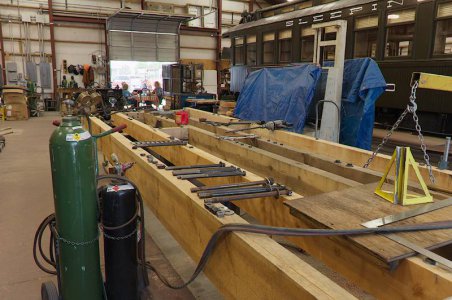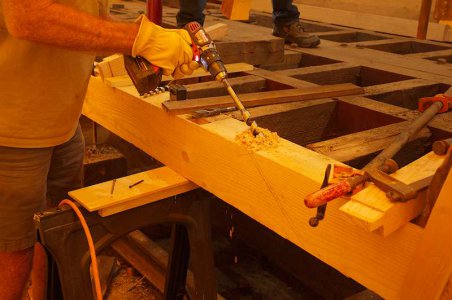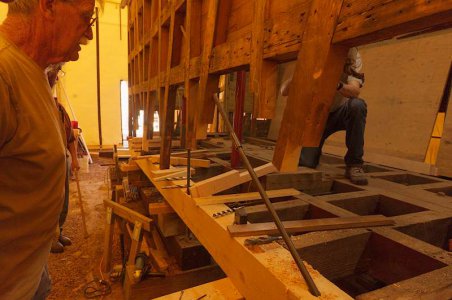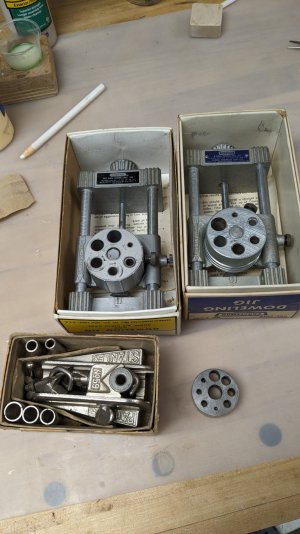- Joined
- Nov 3, 2023
- Messages
- 37
Y'got me recalling my first work session in 2021 with the Friends of the Cumbres and Toltec, working on a flatcar restoration in Antonito, CO. Found out there's actually 3 types of carpentry: 1) finish, 2) framing, and 3) railcar 
They were drilling 1" diameter holes through 14" timbers, important to have the other end come out the right place in order to hang things like airbrake reservoirs. To do this, they fabricated a drill guide:

It's the yellow thing under the hoist hook. I wish I'd taken a picture of it in use; one person just holds it in place and the other stands on the timber and guides the drill using it for angle reference. Once you get a few inches in you're committed to the vector, so the guide is removed to complete the hole. It still didn't guarantee perfect alignment, 14" is a long distance to propagate a small angle, so there was usually a bit of reaming of the hole to shape it to fit.
Fast forward to this past summer, doing a baggage car restoration a bit closer to home in Colorado Springs. Replacing rotten sills, had to drill holes at an angle to accommodate steel reinforcing rods. We'd have spent more time fabricating a one-off version of the yellow thingy, so we ended up just free-drilling with two people to guide the start: one on the side to call 'up/down', the other standing overhead to call 'left/right':

Pardon the orange cast, the project is housed in a canvas shelter. This is after the guiding is done, note the line drawn on the timber.
Of note, that little Milwaukee drill got a lot of disparaging comments at the start of work, most were used to using larger drills down at Antonito. But, it just trundled right through the timber, like watching a physics-ignoring cartoon...
Proof's in the pudding, here's a new rod segment inserted in the hole and sleeved-up with the original we had to cut to remove the sill:


They were drilling 1" diameter holes through 14" timbers, important to have the other end come out the right place in order to hang things like airbrake reservoirs. To do this, they fabricated a drill guide:

It's the yellow thing under the hoist hook. I wish I'd taken a picture of it in use; one person just holds it in place and the other stands on the timber and guides the drill using it for angle reference. Once you get a few inches in you're committed to the vector, so the guide is removed to complete the hole. It still didn't guarantee perfect alignment, 14" is a long distance to propagate a small angle, so there was usually a bit of reaming of the hole to shape it to fit.
Fast forward to this past summer, doing a baggage car restoration a bit closer to home in Colorado Springs. Replacing rotten sills, had to drill holes at an angle to accommodate steel reinforcing rods. We'd have spent more time fabricating a one-off version of the yellow thingy, so we ended up just free-drilling with two people to guide the start: one on the side to call 'up/down', the other standing overhead to call 'left/right':

Pardon the orange cast, the project is housed in a canvas shelter. This is after the guiding is done, note the line drawn on the timber.
Of note, that little Milwaukee drill got a lot of disparaging comments at the start of work, most were used to using larger drills down at Antonito. But, it just trundled right through the timber, like watching a physics-ignoring cartoon...

Proof's in the pudding, here's a new rod segment inserted in the hole and sleeved-up with the original we had to cut to remove the sill:





 Very useful for drilling pipes.
Very useful for drilling pipes.